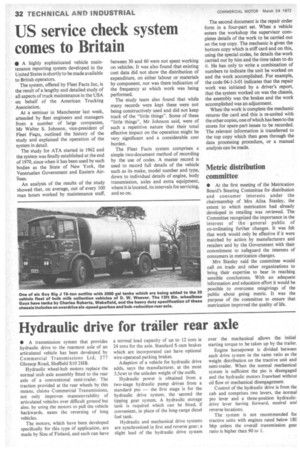US service check system comes to Britain
Page 34

If you've noticed an error in this article please click here to report it so we can fix it.
• A highly sophisticated vehicle maintenance reporting system developed in the United States is shortly to be made available to British operators.
The system, offered by Fleet Facts Inc, is the result of a lengthy and detailed study of all aspects of truck maintenance in the USA on behalf of the American Trucking Association.
At a seminar in Manchester last week, attended by fleet engineers and managers from a number of large companies, Mr Walter S. Johnson, vice-president of Fleet Facts, outlined the history of the study and explained the operation of the system in detail.
The study for ATA started in 1962 and the system was finally established at the end of 1970, since when it has been used by such bodies as the State of New York, the Venezuelan Government and Eastern Airlines.
An analysis of the results of the study showed that, on average, out of every 100 man hours worked by maintenance staff, between 30 and 60 were not spent working on vehicles. It was also found that existing cost data did not show the distribution of expenditure, on either labour or materials by component, nor was there indication of the frequency at which work was being performed.
The study team also found that while many records were kept these were not being constructively used and did not keep track of the "little things". Some of these "little things", Mr Johnson said, were of such a repetitive nature that their total effective impact on the operation might be very significant and a considerable cost burden.
The Fleet Facts system comprises a simple two-document method of recording by the use of codes. A master record is used to record full details of the vehicle such as its make, model number and type, down to individual details of engine, body transmission, axles and extra equipment, where it is located, its intervals for servicing, and so on. The second document is the repair order form in a four-part set. When a vehicle enters the workshop the supervisor completes details of the work to be carried out on the top copy. The mechanic is given the bottom copy which is stiff card and on this, using the special codes, he details the.work carried out by him and the time taken to do it. He has only to write a combination of numbers to indicate the unit he worked on and the work accomplished. For example, the code 04-1-3-01 indicates that the repair work was initiated by a driver's report, that the system worked on was the chassis, the assembly was the brakes and the work accomplished was an adjustment.
When the work is complete the mechanic returns the card and this is re-united with the other copies, one of which has been to the stores for spare part issues to be recorded. The relevant information is transferred to the top copy which then goes through the data processing procedure, or a manual analysis can be made.




















































































































































